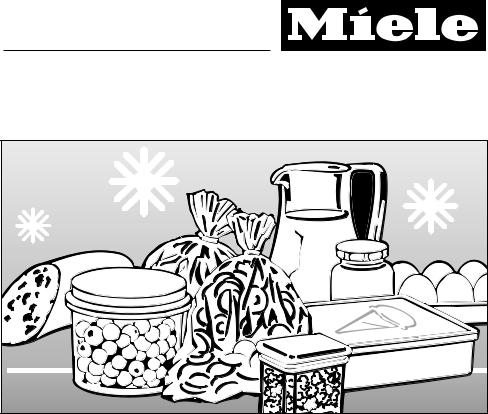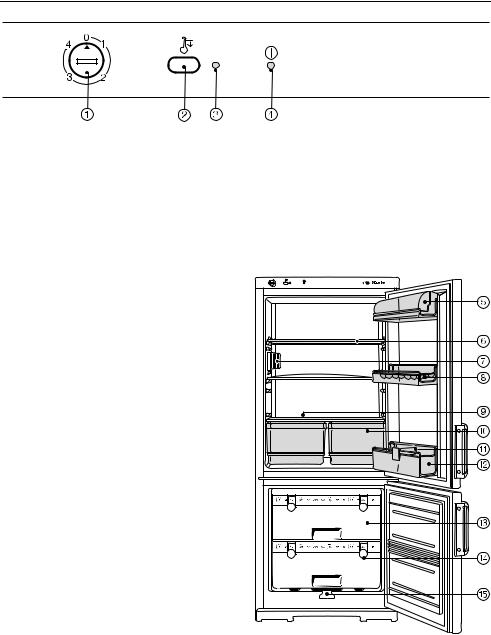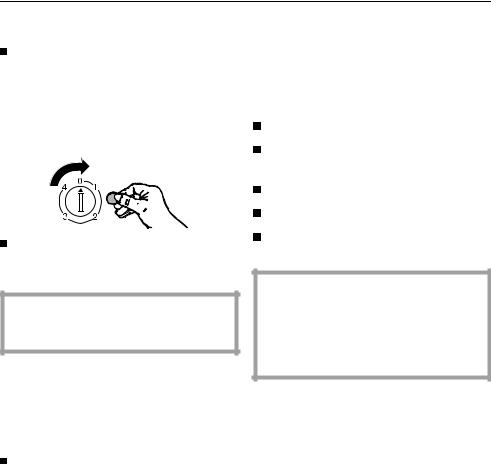Miele KD 3221 S, KD 3222S, KD 3224 S, KD 3421 S, KD 3422 S Operating instructions
...
Operating and installation instructions
Fridge freezer combination
It is essential to read these operating instructions before installing or using the machine, to avoid the risk of accident
or damage to the machine.
Q
M.-Nr. 05 249 020

Contents
Description of the appliance . . . . . . . . . . . . . . . . . . . . . . . . . . . . . . . . . . . . . . . . . 4
Caring for the environment . . . . . . . . . . . . . . . . . . . . . . . . . . . . . . . . . . . . . . . . . . 5
Warning and safety instructions. . . . . . . . . . . . . . . . . . . . . . . . . . . . . . . . . . . . . . 6
Switching on and off . . . . . . . . . . . . . . . . . . . . . . . . . . . . . . . . . . . . . . . . . . . . . . |
10 |
Switching off for longer periods of time . . . . . . . . . . . . . . . . . . . . . . . . . . . . . . . . |
10 |
The correct temperature
. . . in the refrigerator . . . . . . . . . . . . . . . . . . . . . . . . . . . . . . . . . . . . . . . . . . . . . . . 11
. . . in the freezer compartment . . . . . . . . . . . . . . . . . . . . . . . . . . . . . . . . . . . . . . . 11 Temperature selection . . . . . . . . . . . . . . . . . . . . . . . . . . . . . . . . . . . . . . . . . . . . . . 11 Temperature display. . . . . . . . . . . . . . . . . . . . . . . . . . . . . . . . . . . . . . . . . . . . . . . . 12
Winter setting . . . . . . . . . . . . . . . . . . . . . . . . . . . . . . . . . . . . . . . . . . . . . . . . . . . . 13
Storing food in the refrigerator section . . . . . . . . . . . . . . . . . . . . . . . . . . . . . . . 14
Adjusting the interior fittings
Moving the shelves . . . . . . . . . . . . . . . . . . . . . . . . . . . . . . . . . . . . . . . . . . . . . . . . 15 Split shelf . . . . . . . . . . . . . . . . . . . . . . . . . . . . . . . . . . . . . . . . . . . . . . . . . . . . . . . . 15 Adjusting door shelves. . . . . . . . . . . . . . . . . . . . . . . . . . . . . . . . . . . . . . . . . . . . . . 15 Moving the bottle divider . . . . . . . . . . . . . . . . . . . . . . . . . . . . . . . . . . . . . . . . . . . . 15
Chilling and storing food
Important notes: . . . . . . . . . . . . . . . . . . . . . . . . . . . . . . . . . . . . . . . . . . . . . . . . . . . 16 Food which should not be stored in a refrigerator . . . . . . . . . . . . . . . . . . . . . . 16
Freezing and storing food
Maximum freezing capacity . . . . . . . . . . . . . . . . . . . . . . . . . . . . . . . . . . . . . . . . . . 17 Storing frozen food . . . . . . . . . . . . . . . . . . . . . . . . . . . . . . . . . . . . . . . . . . . . . . . . 17 Home freezing . . . . . . . . . . . . . . . . . . . . . . . . . . . . . . . . . . . . . . . . . . . . . . . . . . . . 17 Hints on home freezing . . . . . . . . . . . . . . . . . . . . . . . . . . . . . . . . . . . . . . . . . . . 17 Packing . . . . . . . . . . . . . . . . . . . . . . . . . . . . . . . . . . . . . . . . . . . . . . . . . . . . . . 18 Placing in the freezer . . . . . . . . . . . . . . . . . . . . . . . . . . . . . . . . . . . . . . . . . . . . 18 Freezer calendar . . . . . . . . . . . . . . . . . . . . . . . . . . . . . . . . . . . . . . . . . . . . . . . . . . 19 Marker system for frozen food . . . . . . . . . . . . . . . . . . . . . . . . . . . . . . . . . . . . . . . . 19

Contents
Defrosting . . . . . . . . . . . . . . . . . . . . . . . . . . . . . . . . . . . . . . . . . . . . . . . . . . . . . . . 19 Ice cubes . . . . . . . . . . . . . . . . . . . . . . . . . . . . . . . . . . . . . . . . . . . . . . . . . . . . . . . . 19 Ice cream . . . . . . . . . . . . . . . . . . . . . . . . . . . . . . . . . . . . . . . . . . . . . . . . . . . . . . . . 20 Cooling drinks . . . . . . . . . . . . . . . . . . . . . . . . . . . . . . . . . . . . . . . . . . . . . . . . . . . . 20 Freezer tray . . . . . . . . . . . . . . . . . . . . . . . . . . . . . . . . . . . . . . . . . . . . . . . . . . . . . . 20 Ice pack . . . . . . . . . . . . . . . . . . . . . . . . . . . . . . . . . . . . . . . . . . . . . . . . . . . . . . . . . 20
Defrosting
Refrigerator section . . . . . . . . . . . . . . . . . . . . . . . . . . . . . . . . . . . . . . . . . . . . . . . . 21 Freezer section. . . . . . . . . . . . . . . . . . . . . . . . . . . . . . . . . . . . . . . . . . . . . . . . . . . . 21
Cleaning and care
Cleaning the outer casing, the interior and accessories . . . . . . . . . . . . . . . . . . . . 23 Ventilation gaps . . . . . . . . . . . . . . . . . . . . . . . . . . . . . . . . . . . . . . . . . . . . . . . . . . . 23 Door seals . . . . . . . . . . . . . . . . . . . . . . . . . . . . . . . . . . . . . . . . . . . . . . . . . . . . . . . 23 Metal grille at the back of the appliance . . . . . . . . . . . . . . . . . . . . . . . . . . . . . . . . 24 After cleaning. . . . . . . . . . . . . . . . . . . . . . . . . . . . . . . . . . . . . . . . . . . . . . . . . . . . . 24
Problem solving guide. . . . . . . . . . . . . . . . . . . . . . . . . . . . . . . . . . . . . . . . . . . . . 25
After Sales Service. . . . . . . . . . . . . . . . . . . . . . . . . . . . . . . . . . . . . . . . . . . . . . . . 28
Electrical connection . . . . . . . . . . . . . . . . . . . . . . . . . . . . . . . . . . . . . . . . . . . . . . 29 Electrical connection U.K. . . . . . . . . . . . . . . . . . . . . . . . . . . . . . . . . . . . . . . . . . . . 29
Installation
Location . . . . . . . . . . . . . . . . . . . . . . . . . . . . . . . . . . . . . . . . . . . . . . . . . . . . . . . . . 31 Climate range . . . . . . . . . . . . . . . . . . . . . . . . . . . . . . . . . . . . . . . . . . . . . . . . . . 31 Ventilation . . . . . . . . . . . . . . . . . . . . . . . . . . . . . . . . . . . . . . . . . . . . . . . . . . . . . . . . 31 Fitting the handles . . . . . . . . . . . . . . . . . . . . . . . . . . . . . . . . . . . . . . . . . . . . . . . . . 31 Installation . . . . . . . . . . . . . . . . . . . . . . . . . . . . . . . . . . . . . . . . . . . . . . . . . . . . . . . 32 Align the appliance . . . . . . . . . . . . . . . . . . . . . . . . . . . . . . . . . . . . . . . . . . . . . . . . 32
Changing the door hinging . . . . . . . . . . . . . . . . . . . . . . . . . . . . . . . . . . . . . . . . 33
Building in. . . . . . . . . . . . . . . . . . . . . . . . . . . . . . . . . . . . . . . . . . . . . . . . . . . . . . . 35

Description of the appliance
bOn-/Off and temperature dial |
eIn-operation indicator light |
cButton for winter setting |
|
dIndicator light for winter setting |
|
fButter and cheese compartment gShelves
hInterior lighting iEgg trays
jCondensate channel and drain hole
kFruit and vegetable containers lDivider
mDoor shelves
nDrawers with freezer calendar
oMarker system for frozen food
pOutlet guide for defrosted water
4

Caring for the environment
Disposal of the packing material
The transport and protective packing has been selected from materials which are environmentally friendly for disposal and can normally be recycled.
Rather than just throwing these materials away, please ensure they are offered for recycling.
Disposal of your old appliance
Old appliances contain materials which can be reclaimed or recycled. Please contact your dealer, your waste collection centre or scrap merchant about potential recycling schemes.
Make sure that the pipework is not damaged whilst moving an old appliance. This is to ensure that the refrigerant can be disposed of in an environmentally safe manner.
Ensure that the appliance presents no danger to children while being stored for disposal.
See the appropriate section in the Warning and safety instructions.
5

Warning and safety instructions
This appliance complies with all relevant legal safety requirements. Improper use of the appliance can, however, present a risk of both personal injury and material damage.
Before installation and before using for the first time, read the operating instructions carefully. They contain important notes on safety, the operation and care of the appliance.
This way you will avoid the risk of accidents and damage to the appliance.
Keep these instructions in a safe place and pass them on to any future user.
Correct usage
This appliance is intended for domestic use only for the cool storage of foodstuffs as well as for storing deep frozen food, freezing fresh food
and for preparing ice.
Any other usage is not supported by the manufacturer and could be dangerous. The manufacturer cannot be held responsible for damage caused by improper use of the appliance.
Technical safety
This appliance contains the coolant Isobutane (R600a), a natural gas which breaks down naturally. It is
however flammable. Care must be taken during transportation and setting up of the appliance that no parts of the cooling system are damaged. Leaking refrigerant can damage the eyes.
In the event of refrigerant escaping:
–avoid open fires
and anything which creates a spark,
–disconnect from the mains,
–air the room in which the appliance is located for several minutes and
–contact the Service Department for advice.
The more refrigerant there is in an appliance the larger the room it
should be installed in. In the event of a leakage, if the appliance is in a small room, there is the danger of combustible gases building up.
For every 8 g of coolant at least 1 m3 room space is required. The amount of coolant in the appliance is stated on the data plate inside the appliance.
Before connecting the appliance to the mains supply, make sure that
the rating on the data plate corresponds to the voltage and frequency of the household supply.
This data must correspond in order to avoid risk of damage to the appliance. If in any doubt, consult a qualified electrician.
6

Warning and safety instructions
The electrical safety of this appliance can only be guaranteed
when continuity is complete between the appliance and an effective earthing system which complies with local and national safety regulations. It is most important that this basic safety requirement is tested by a qualified electrician.
The manufacturer cannot be held responsible for the consequences of an inadequate earthing system (e.g. electric shock).
Safe operation of the appliance is only assured if it has been installed
and connected in accordance with these operating and installation instructions.
Installation work, maintenance and repairs may only be carried out by
suitably qualified and competent persons.
Repairs and other work by unqualified persons could be dangerous and the manufacturer will not be held responsible.
Ensure current is not supplied to the appliance while maintenance
or repair work is being carried out.
The appliance is only completely isolated from the electricity supply
when:
–the plug has been withdrawn.
Do not pull on the cable, only on the plug.
–the mains fuse is withdrawn.
–or the screw-out fuse is removed (in countries where this is applicable).
Do not connect the appliance to the mains electricity supply by an
extension lead.
Extension leads do not guarantee the required safety of the appliance, (e.g. danger of overheating).
Use
Never handle frozen food with wet hands. Your hands may freeze to
the frozen food. Danger of frost burn.
Do not take ice cubes out with your bare hands and never place
ice cubes or ice lollies in your mouth straight from the freezer. The very low temperature of the frozen ice or lollies can cause frostburn to the lips or tongue.
Do not refreeze thawed or partially thawed food.
Defrosted food should be used up as quickly as possible as food soon loses it nutritional value and goes off. Defrosted food may only be re-frozen after it has been cooked.
Never store explosive materials in the appliance. Switching on
thermostats and the interior light may produce sparks which could present a fire hazard.
If storing alcohol with a high percentage proof in the cool zone,
make sure it is tightly closed and stored upright.
Danger of explosion.
7

Warning and safety instructions
Do not store cans or bottles containing carbonated drinks or
liquids which could freeze in the freezer section. The cans or bottles could explode.
Danger of injury and damage to the appliance.
When cooling drinks quickly in the freezer, make sure bottles are not left in for more than one hour, otherwise
they could burst. Danger of injury and damage to the appliance.
Observe the “use by” dates given on food to avoid the risk of food
poisoning. Storage times will depend on several factors including the freshness and quality of the food as well as the temperature at which it is stored.
Follow the instructions given on food manufacturer’s packaging on storage conditions required as well as the “use by” date.
Do not use sharp edged objects to
–remove frost and ice,
–separate frozen foods and remove
ice trays.
They will damage the evaporator and the appliance will not be able to be used again (total damage).
Never place electric heaters or candles in the appliance to defrost
it. These can damage the plastic parts.
Do not use defrosting sprays, or de-icers as they could contain sub-
stances which could damage the plastic parts and which may cause the build up of gases and pose a danger to health.
Do not use any grease or oil on the door seals. These cause the seals to become porous in the course of time.
Do not block the ventilation gaps in the appliance, as this would im-
pair the efficiency of the appliance, increase the electricity consumption and could cause damage to the appliance.
The appliance is designed for use within certain climate ranges (am-
bient temperatures). It must not be used in ranges for which it is not designed. The climate range for your appliance is stated on the data plate inside the appliance.
Installing it in a room with too low an ambient temperature will lead to the appliance switching off for longer periods so that it cannot maintain the required temperature.
Never use steam cleaning apparatus to defrost or clean the ap-
pliance. The steam could attack the electrical components and cause a short circuit.
In countries where there are areas which may be subject to infesta-
tion by cockroaches or other vermin, pay particular attention to keeping the appliance and its surroundings in a clean condition at all times. Any damage which may be caused by cockroaches or other vermin will not be covered by the appliance guarantee.
8

Warning and safety instructions
Disposal of old appliances
Before disposing of an old appliance first make the door latch or
lock unusable.
This way you will prevent children from accidentally locking themselves in and endangering their lives.
Before disposing of an old appliance, unplug it and render the
plug useless. Cut off the cable directly behind the appliance and at the plug to prevent misuse.
Be careful not to damage any part of the pipework whilst awaiting dis-
posal, e.g. by
–puncturing the refrigerant channels in the evaporator.
–bending any pipework.
–scratching the surface coating. Splashes of refrigerant can damage the eyes.
The manufacturer cannot be held liable for damage caused by noncompliance with these Warning and safety instructions.
9

Switching on and off
Before using for the first time
Clean the inside of the appliance and the accessories with luke warm water and a little washing up liquid and then dry using a soft cloth.
Switching on
Using a coin turn the On/Off dial in a clockwise direction away from the “0” position.
Forcing it beyond its range would damage it. Turn it only as far as it will go, then turn it back again.
The appliance will begin to cool. The interior light will come on when the door is opened.
Switching off
Using a coin turn the On/Off dial in an anti-clockwise direction back to the “0" position.
The cooling system and the interior light are now switched off.
Switching off for longer periods of time
If the appliance is not going to be used for a longer period of time, e.g. whilst on holiday
switch the appliance off at the mains,
withdraw the plug (pull on the plug and not the cable),
defrost the freezer section
clean the appliance
leave the doors slightly ajar to air the appliance.
If, during a long absence, the appliance is switched off but not cleaned out and the doors are left shut there is a danger of mould and odours building up inside the appliance.
10

The correct temperature
It is very important to set the correct temperature for storing food in the appliance. Micro organisms will cause food which is not stored at the correct temperature to deteriorate rapidly. Temperature influences the growth rate of these micro organisms. Reducing the temperature reduces their growth rate.
The temperature in the appliance will rise:
–the more often the door is opened and the longer it is kept open,
–if too much food is stored in it at once,
–the warmer the food is which is put into it,
–the higher the ambient temperature surrounding the appliance.
The appliance is designed for use in specific ambient temperatures (climate ranges). Do not use in ambient temperatures for which it is not designed.
. . . in the refrigerator
We recommend a temperature of 5 °C in the middle of the appliance.
. . . in the freezer compartment
For freezing fresh food and storing frozen food for a long time a temperature of at least -18 °C is needed. At this temperature the growth of micro organisms is generally halted. As soon as the temperature rises to above -10 °C, the micro organisms become active in the food again so that it cannot be kept as long. Partially defrosted or defrosted food must not be re-frozen. Food may be re-frozen once it has been cooked as the high temperatures achieved when cooking destroy most organisms.
Temperature selection
Use the temperture selector to select the temperature.
Using a coin turn the temperature dial in a clockwise direction to the required setting.
Forcing it beyond its range would damage it. Turn it only as far as it will go, then turn it back again.
The higher the setting, the lower the temperature in the appliance.
We recommend a medium setting.
11
